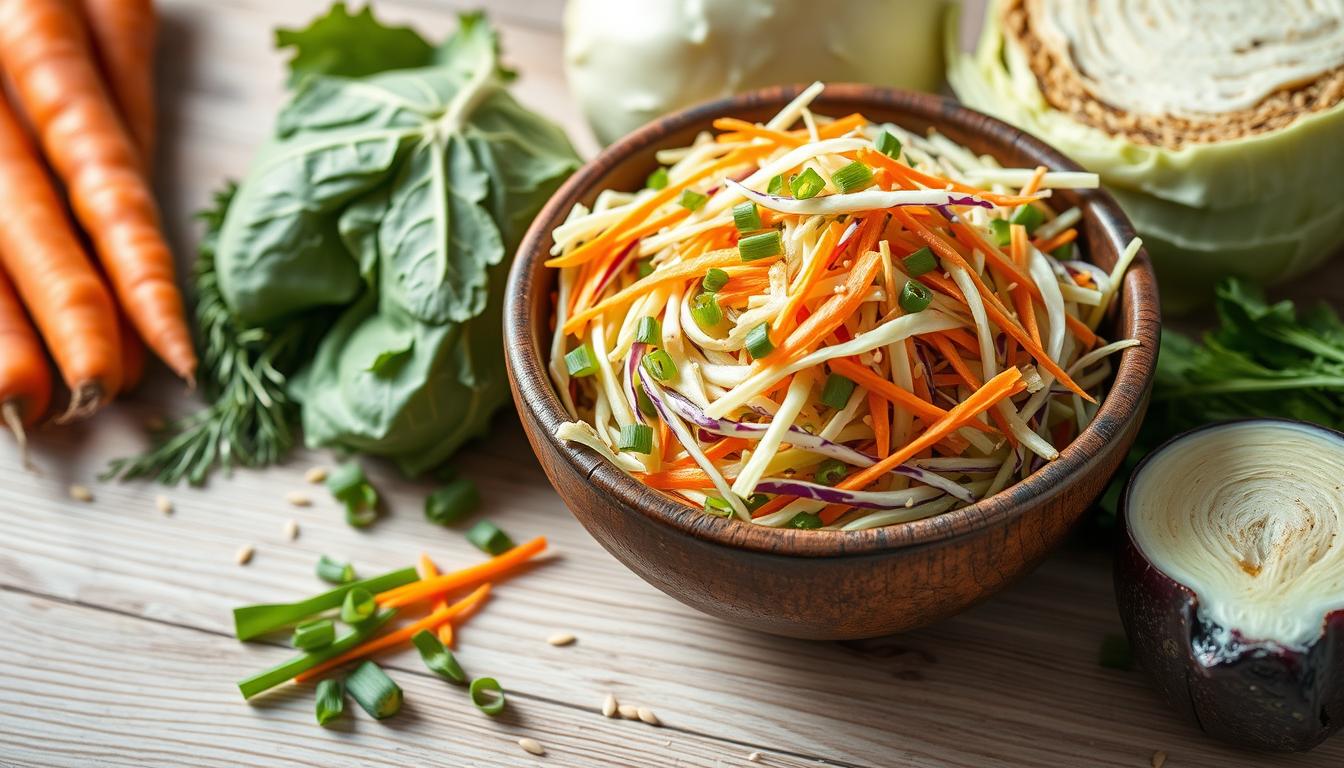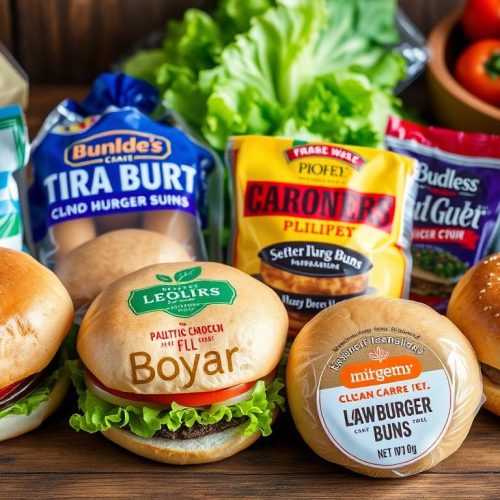If you have diabetes, you might wonder about coleslaw. It’s a tasty side dish. But is Coleslaw Good for Diabetics? The answer is yes, with a few tweaks.
We’ll look at coleslaw’s nutrition and how it affects blood sugar. We’ll also show you how to make a low-carb, homemade coleslaw. It’s great for people with diabetes.
 alt=”is coleslaw good for diabetics” data-id=”146115108″ />
alt=”is coleslaw good for diabetics” data-id=”146115108″ />
Learning about the glycemic index of coleslaw ingredients is key. By making smart swaps, you can make a low-sugar coleslaw. Let’s explore how to make a diabetic-friendly coleslaw that’s delicious and guilt-free.
Understanding Coleslaw and Blood Sugar Impact
Coleslaw can affect blood sugar levels. It’s key to know the glycemic index of its ingredients. The glycemic index shows how fast a food raises blood sugar.
Glycemic Index of Common Coleslaw Ingredients
Cabbage, the main part of coleslaw, has a low glycemic index. It ranges from 10 to 15. This means cabbage doesn’t raise blood sugar much.
Carrots and onions in coleslaw also have low glycemic indexes. They are usually below 50.
The dressing in coleslaw is the big problem. Traditional dressings have a lot of sugar. This makes the dish’s glycemic index very high. So, does coleslaw have a lot of sugar? is a big question for people with diabetes.
How Traditional Coleslaw Affects Blood Glucose
Traditional coleslaw has mayonnaise, sugar, vinegar, and sometimes high-fructose corn syrup. These add a lot of carbs and calories. They’re not good for people with diabetes.
The sugar in the dressing and the cabbage can quickly raise blood sugar. This makes regular coleslaw bad for those with diabetes.
To make coleslaw better for diabetes, use different dressings. Try to add less sugar and carbs.
Is Coleslaw Good for Diabetics: Breaking Down the Facts
Managing diabetes means choosing the right foods. Coleslaw, made from shredded cabbage, is often debated. Is it good for diabetics, or should they avoid it? Let’s explore the good and bad of coleslaw in a diabetic diet.
The benefits of eating coleslaw for diabetics come from cabbage. It’s a low-glycemic veggie that doesn’t raise blood sugar much. It’s also full of dietary fiber, which helps with digestion and feeling full. These are key for managing blood sugar.
But, traditional coleslaw with high-sugar dressing is a problem for diabetics. The sugar in coleslaw dressings can quickly raise blood sugar. To make coleslaw better for diabetics, use low-sugar dressing recipes and watch your portions.
| Ingredient | Glycemic Index |
|---|---|
| Cabbage | 10 |
| Carrots | 47 |
| Mayonnaise (regular) | 0 |
| Sugar | 65 |
Knowing the glycemic index of coleslaw ingredients helps. With smart swaps, coleslaw can be a tasty, diabetes-friendly side dish.
 alt=”coleslaw” data-id=”146115110″ />
alt=”coleslaw” data-id=”146115110″ />
Nutritional Benefits of Cabbage-Based Dishes for Diabetics
Managing diabetes means watching what you eat. Cabbage, in coleslaw, is great for diabetics. It’s full of good stuff for your diet.
Essential Vitamins and Minerals
Cabbage has lots of vitamins and minerals good for diabetics. It’s full of vitamin C to help your immune system. It also has vitamin K for blood and bones. Plus, it has folate for growing cells.
Fiber Content and Blood Sugar Management
What are the benefits of eating coleslaw? It’s because cabbage has lots of fiber. Fiber makes carbs absorb slower, keeping blood sugar steady. Low carb coleslaw is especially good for diabetics, with cabbage’s fiber without extra sugar.
Anti-inflammatory Properties
Cabbage and veggies like broccoli and kale fight inflammation. Inflammation is a big problem for diabetics. Eating these veggies can help lower your risk of health problems.
Knowing cabbage’s benefits helps diabetics make better food choices. Adding what are the benefits of eating coleslaw? to your meals is tasty and helps manage diabetes.
Making Your Coleslaw Diabetes-Friendly: Key Modifications
If you have diabetes and love coleslaw, you can make it safe to eat. Just a few changes to the recipe can help. You’ll get a tasty, low-sugar coleslaw that’s good for your health.
First, cut down on the sugar in the dressing. Traditional coleslaw has a lot of sugar, which isn’t good for your blood sugar. Try using stevia or erythritol instead. They add sweetness without raising your blood sugar.
Next, use more low-sugar coleslaw ingredients like cabbage and carrots. These veggies are full of fiber and vitamins. You can also add broccoli, cauliflower, or radishes to your homemade coleslaw.
For the dressing, choose a low-sugar or sugar-free mayonnaise or yogurt. Stay away from creamy, high-fat dressings. They can make your blood sugar go up and down. Adding apple cider vinegar or lemon juice gives flavor without extra carbs.
With these easy changes, you can make basic coleslaw for diabetics that’s tasty and safe. Enjoy your crunchy, flavorful coleslaw without worrying about your blood sugar.
Low-Carb Coleslaw Recipe for Diabetics
Are you a diabetic looking for a tasty coleslaw recipe? This low-carb coleslaw is great for managing blood sugar. It’s also delicious as a side dish.
Ingredient List and Substitutions
- 1 medium head of green cabbage, shredded or thinly sliced
- 1 medium carrot, grated
- 1/4 cup diced onion
- 1/2 cup plain, unsweetened Greek yogurt
- 2 tablespoons apple cider vinegar
- 2 tablespoons Dijon mustard
- 1 tablespoon erythritol or other low-calorie sweetener
- Salt and pepper to taste
Want a dairy-free version? Use unsweetened almond or coconut milk yogurt instead. For a creamier dressing, add a tablespoon of mayonnaise.
Step-by-Step Preparation Guide
- In a large bowl, mix the shredded cabbage, grated carrot, and diced onion.
- In another bowl, mix the Greek yogurt, apple cider vinegar, Dijon mustard, and sweetener until smooth.
- Pour the dressing over the cabbage mix and toss gently to coat.
- Season with salt and pepper to taste.
- Cover and chill the coleslaw for at least 30 minutes to blend flavors.
Storage and Serving Tips
This coleslaw keeps in an airtight container in the fridge for up to 5 days. It’s perfect with grilled meats, fish, or on low-carb burgers or sandwiches. Adjust serving size for your carb needs.
 alt=”low carb coleslaw” data-id=”146115112″ />
alt=”low carb coleslaw” data-id=”146115112″ />
Best Sugar Alternatives for Diabetic Coleslaw
Creating a low sugar coleslaw for diabetics means picking the right sweetener. Regular coleslaw uses sugar, which can raise blood sugar. But, there are natural and artificial sweeteners that are safe and sweet.
Stevia is a plant-based sweetener with no calories. It doesn’t raise blood sugar much. You can add it to your homemade coleslaw for a sweet taste without the sugar rush.
Erythritol is another good choice. It’s a sugar alcohol that’s okay for many diabetics. It tastes like sugar but doesn’t raise blood sugar much.
- Monk fruit sweetener is a natural, zero-calorie choice. It adds sweetness to your coleslaw without sugar’s carbs.
- Xylitol, from birch trees, is another sugar alcohol. It can sweeten your coleslaw while keeping blood sugar healthy.
Start with small amounts of these sweeteners. Adjust to taste. Also, watch the carbs in your coleslaw, even with natural sweeteners.
“Incorporating the right sugar alternatives can transform a traditional coleslaw into a delicious, diabetes-friendly side dish.”
Try these low sugar coleslaw options for a tasty, diabetes-safe side. Mix different sweeteners to find the perfect taste for you.
Tips for Choosing the Right Vegetables and Dressing
When making a tasty coleslaw for diabetics, picking the right veggies and dressing is key. Choose low-carb veggies and a healthy, low-sugar dressing. This way, you can have a yummy coleslaw that won’t raise your blood sugar.
Selecting Fresh Produce
The base of a great coleslaw is the cabbage. For a low carb coleslaw, pick green or red cabbage. They’re low in carbs and full of fiber. Don’t add too many high-carb veggies like carrots, as they can up the carb count.
- Choose crisp, vibrant heads of green or red cabbage for the best texture and flavor.
- Consider adding shredded broccoli or kale to your coleslaw for an extra nutritional boost.
- Dice or julienne the vegetables to create a uniform, bite-sized texture.
Healthy Dressing Options
The dressing is where you can really make a basic coleslaw for diabetics shine. Avoid traditional mayonnaise-based dressings, which are high in fat and sugar. Instead, try healthier options that won’t raise your blood sugar:
- Greek Yogurt Dressing: Mix plain, unsweetened Greek yogurt with a touch of apple cider vinegar, Dijon mustard, and your preferred low-calorie sweetener.
- Avocado Lime Dressing: Blend avocado, lime juice, olive oil, and a pinch of salt and pepper for a creamy, tangy dressing.
- Vinegar-Based Dressing: Combine apple cider vinegar, olive oil, Dijon mustard, and your choice of herbs and spices for a light, flavorful coating.
By picking the right veggies and making a diabetes-friendly dressing, you can enjoy a tasty and healthy coleslaw. This coleslaw won’t mess with your blood sugar control.
Common Mistakes to Avoid When Making Diabetic Coleslaw
When making coleslaw for diabetics, avoid hidden sugars. Sweetened yogurt or high-calorie mayonnaise can raise blood sugar. Also, eating too much can happen even with healthy ingredients.
Choosing the wrong veggies is another mistake. While cabbage is good, adding dried fruits or sweetened nuts is bad. Pick the right veggies and dressing for a healthy coleslaw.
To avoid mistakes, watch the carbs in each ingredient. Read labels well and try low-carb substitutes. This way, you can make a tasty, healthy coleslaw that’s good for your health.
FAQ
Is coleslaw good for diabetics?
Coleslaw can be good for diabetics if made right. Traditional recipes might have too much sugar. But, you can make a version that’s safe for diabetes.
Does coleslaw have a lot of sugar?
Yes, traditional coleslaw has a lot of sugar. This is from the dressing or added sweeteners. But, you can make it better by using less sugar.
What are the benefits of eating coleslaw for diabetics?
Cabbage in coleslaw is low in carbs but full of vitamins and minerals. These help keep your health good and might help control blood sugar. The fiber in coleslaw also helps digest carbs slowly.
How can I make coleslaw more diabetic-friendly?
For a diabetic-friendly coleslaw, use a dressing with less sugar. Try vinegar or Greek yogurt. Use low-carb veggies like cabbage, carrots, and celery. Avoid sweeteners like dried fruits.
What is a good low-carb coleslaw recipe for diabetics?
A good recipe has shredded cabbage, carrots, and a low-sugar dressing. Use vinegar, Greek yogurt, and a bit of sweetener. Add veggies like bell peppers and onions for more nutrition.






